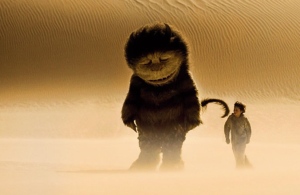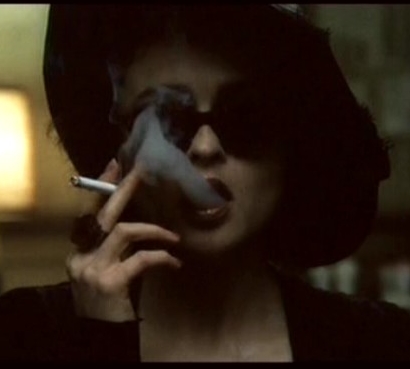
by Miné Salkin | Nov 14, 2009 | film stripped, news
[youtube=http://www.youtube.com/watch?v=ukxu8FgrW10]
An eye-popping delight for the indie-experimental lover.
I don’t think I’ve seen a decent music video since the 1990s. I believe the last “good” one would either be Radiohead’s “Just” (1995) or “Californication” by the Red Hot Chilli Peppers in 1999. A music video that doesn’t detract from the beauty of the song itself is a fine balance most bands and video directors bludgeon with a club.
This time, leave it to the Danish to make something interesting, beautiful and haunting. Oh No Ono is an alternative experimental space-rock band from Copenhagen. Their fourth album Eggs hit the shelves this week. The single “Swim” is delicately layered, with chorus singing and complex instrumental passages reminiscent of the Arcade Fire. Part eerie, part intriguing, the song is unforgettable.

Oh No Ono looking pretty
The video, directed by fellow Dane Adam Hashemi, is a sweet coming-of-age story about an over-imaginative and aroused child. It’s about the shame of the first sexual experience, from the perspective of a creepy pre-pubescent boy. Like I said, I was surprised to find a music video that I would enjoy again!

by Miné Salkin | Nov 12, 2009 | film stripped
Children of divorce, loneliness and other magical things
It might be a children’s book, but this is no film for children. I walked into the movie theatre thinking it would make me feel like a child again, but instead I was presented with a familiar vision of childhood divorce, neglect and naivety, without the Freudian psychobabble.
Inspired by Maurice Sendak’s quintessential book, Where The Wild Things Are reminds us of what it’s like to be a lonely, confused albeit imaginative child. Through ten years in the making, the book’s ten sentences drawn from the alter-egos of innovative director Spike Jonze haven’t lead us to naught.

It’s been a while since Jonze showed us the dysfunction and authenticity-grabbing tendencies of the human mind, but Where The Wild Things Are shows off his greatest talent: it’s a convincing delivery of a more tender childhood experience sure to make most grown-ups weep. Like in Being John Malkovich, it’s a portal into the quirky mind and suggestive consciousness of the nine-year-old Max (Max Records), the universal only child, lover of forts and make-believe.
Where’s your daddy?
I read this book to death when I was a child. Most people under fifty have held the beloved story in their hands, heads and hearts. Max’s cheeky mischief leads his mother to banish him to his room, a familiar punishment we’ve all had. If you were an only child like Max and I, you’d have to come up with a way to entertain yourself. You’d never stray too far from home though, away from your mother’s blanketing love and the hot dinner waiting for you.
My parents separated in 1992 during the second highest peak in divorce records during the 20th century. It was more or less a statistical inevitability that it would be my family, aside from the fact that my parents didn’t get along anymore. I remember being whisked away by my mother. I didn’t rebel in the ordinary ways, by getting in trouble at school or acting out at home. Instead, I became the laziest eight-year-old child in the world. It was impossible to rouse me from my room or the little reading forts I made out of blankets in the den. Those covers blinded me from an outside world I didn’t understand, and helped muffle out the loud, operatic movements of my parents’ feuding. I don’t remember playing outside with many children, or even seeing the sky very often. That book was my medicine for loneliness.
Max is like that too. Who is this stranger kissing my mom in the living room? The rage and sense of betrayal carry through cinematically, intimately as Max peers cautiously over the door frame, shouldering the curiosity mingled with confusion. Like a lot of children of divorce, I saw very similar things, but didn’t understand them. Back into the reading fort I went.
A little bit of loneliness is good
When Judith (Catherine O’Hara) asks Max what the cure for loneliness is, his reply is both beautifully and simple, that “a little loneliness is good.”
The Jonzeian vision of this kind of childhood is powerful, because he side-steps the complexity of broken family life by diverting us to the realm of endless imagination. There’s a sadness and beauty in the way Max’s loneliness makes its way into his imagination. He’s in a place we’ve all been to, where your greatest defence was being bigger than anyone around you. After all, what greater fear was there than getting gobbled up by a monster?
Freud and other monsters
When Sendak’s book was published in 1964, a dumpster bin-sized amount of literature spewed out, upchucking explanations for the monsters as oversized, morality play characters, each representing a basic human emotion. Monster Carol (James Gandolfini) could easily be read as a transvestite with an insatiable sexual hunger, hence his voracious appetite for past kings. The asexuality of these creatures could be a Freudian buffet of psychoanalytic opinion. Enough is enough.
Jonze has no patience for this either, and the film manages to bypass the usual jargon of theory. He’s not showing us anything about children because we see them traumatized by the actions of their desperately lonely parents, but rather, the states of play Max delves into.
In the end, this film wasn’t so much about wanting to reconstruct the idea of childhood. Some Freudian theories might explain that as the crux of the book, as some digestible symbol for the fine line between fear, comfort and some deep-seated desire to gobble up your own mother. In reality, you just wanted her to pay more attention to you.
Check out the trailer. It should warm your heart.
[youtube=http://www.youtube.com/watch?v=HS0h9RaP9cw]

by Miné Salkin | Feb 5, 2009 | film stripped
Based on the best-selling novel by Sophie Kinsella, P.J. Hogan’s film Confessions of a Shopaholic will be playing in theaters this February 13th, just in time for Valentine’s day.
Our headstrong, but sweet and suggestible protagonist Rebecca Bloomwood (Isla Fisher) embodies the concept of financial deficit through her insatiable materialism. The Aussie actress tells The Herald Sun that the consumerist fetishization shown in the film will inspire consumption and public spending, hopefully to revitalize the economy. (more…)

by Miné Salkin | Feb 4, 2009 | film stripped
This Tuesday, Kevin Smith‘s latest film Zack and Miri Make a Porno will come to DVD.
It’s a film about lifelong platonic friends who are broke, disillusioned with their dead-end jobs, and cohabitate in financial squalor. Much like the global financial crisis they need to come up with a “stimulus package” and thus decide to film a pornographic movie so they can have their heat, hot water and electricity again.
Instead, they find the greatest electricity of all as they fall madly in love during the production.
It begins by showing the camaraderie of best friends—Zack Brown (Seth Rogen) and Miriam Linky (Elizabeth Banks) are roommates who are just starting their day in frosty Pittsburgh. Miri’s in the kitchen making coffee when camera pans out for us to see a mass of unpaid bills, dirty dishes and the sad crumbs of deep-seated depression.
The pair gets their great idea at their ten-year high school reunion from porn star celebrity, who boasts that the gay porn industry brings him nearly $100,000 USD a year for the production and distribution of his films.
While Zack and Miri may be able to drag themselves out of their financial skids, the profitability of the porn industry is not what it initially claimed to be. A year ago, Newsweek wrote that the size and value of the business was always unclear, which isn’t surprising for an industry that depends on enlarging its appearance. In 2001, Forbes reported that the “Business of Smut” was valued at $2.6 billion to $3.9 billion annually, which isn’t even close to the Forrester Research that estimated $10 billion.

Zack and Miri discover lust first, love second
The film touches on this a little bit, and has all of the traditionally crude jabs and jokes that porn incites. It even stars former Penthouse model Traci Lords, whose audition involves blowing soap bubbles out of her vagina. “It’s a little something I picked up doing bachelor parties,” she says chewing bright pink bubble gum.
Overall, the film shows how the illusion of pornography hides other meanings. In the financial world, it has the semblance of being more profitable than it actually is, but that is because porn is far more mainstream than people think it is. For Zack and Miri, the illusion of making a pornographic film together brings out deeper feelings for each other that they were previously unaware of.
Miri: So… what about me? How do I look?
Zack: I mean, you look beautiful – you always look… so beautiful, so I guess it’s not a big deal. But you… you look amazing.
Miri: [grabbing his hand lovingly, then quickly beginning to swing it back and forth] Okay! Let’s go make a porno!
For those who don’t know, Smith has a substantial roster of subversive films. His 1997 flick Chasing Amy starred Joey Lauren Adams, a comic book illustrator whom Ben Affleck falls madly in love with, only to learn that she is a lesbian.
His style has been likened to Judd Apatow’s, the director who brought similar off-beat, crude comedies such as The 40-Year-Old Virgin and Superbad.
While Zack and Miri largely depended on perverted humour and awkwardly graphic sex scenes, it was surprisingly heartwarming.

by Miné Salkin | Jan 19, 2009 | film stripped
“It’s true! Vagina dentata! Vagina dentata! Vagina dentata!”
Someone on the bus the other day was talking very loudly about a film where the main character had teeth in her vagina. Intrigued, I later discovered on an IMDB search that he was referencing Mitchell Lichtenstein‘s (son of Pop-Artist Roy) 2007 film Teeth. After watching the disturbing movie, it had an interesting effect of combing classic mythology with the modern woman becoming empowered by self-acceptance.
It blurs the lines between the power of female revenge, the idea of women as objects of violence, retribution, and the age-old phenomenon of gynophobia. Toting the tag line that “Every rose has its thorns,” Lichtenstein shows how women can be very scary things indeed.
The story is centered around Dawn O’Keefe (Jess Weixler), who is going through the normal growing pains of adolescence. Like her name represents the promise of a new day, Dawn remains abstinent despite the increasingly inappropriate sexual encounters she is subjected to by her stepbrother, stepfather, and the brutally intrusive gynecologist. Caught somewhere between a horror and a comedy, the hybrid genre adds a surrealistic tone to the realities of rape in America, and modern misogyny.

Sex changes everything
According to the Rape, Abuse & Incest National Network (RAINN), 60% of sexual assaults in America are not reported to the police. Maybe movies like this will deflate that horrifying statistic, or at least give sexually abused women the power they need to speak out.
The bildungsroman of the film is when Dawn realizes that she has power over the men in her life because she is the potential object for violence. Enshrouded by the veil of “the other” she is able to retaliate because men just don’t understand her, and are too ignorant to ask. Not only that, but she has incisors in her vagina that grind mechanically, involuntarily, at any time that she is penetrated.
As Hélène Cixous wrote in the Laugh of the Medusa (1976), it is the riveting story of two horrifying myths: the Medusa and the abyss. The woman and her mystery. Instead of trying to understand it, men fear it. “The phallologocentric sublation is with us, and it’s militant, regenerating the same old patterns, ” which in this case, is the dogma of castration.
“The toothed vagina appears in the mythology of many and diverse cultures all over the world. In these myths, the story is always the same. The hero must do battle with the woman. The toothed creature can break her power,” Dawn explains.
So it seems like the best thing for a man to do is to try to get to know a girl first. If it’s fear of the unknown, the incalculable, or the general mysterious aura of a woman, it’s a good idea to say “please.”

by Miné Salkin | Jan 13, 2009 | film stripped
From the evil, the downtrodden, to the genuinely heart warming, here is a list of five very memorable female acts:
5. Marla Singer, Fight Club (1999). David Fincher casts Helena Bonham-Carter to play the love interest of both Tyler Durden and his alter-ego, jointly played by Edward Norton and Brad Pitt. In a world where Tyler’s insomnia leads him through a self-induced hell, the film shows the spiritual progression from a mundane existence to the rejection of the material life in favour of anarchism. Marla the greasy, filthy, chain-smoking and Xanax-popping woman is the single most stable character in this Fincher reality. I tip my hat to you, madame.
“Marla… the little scratch on the roof of your mouth that would heal if only you could stop tonguing it, but you can’t.”

Marla Singer: a dirty girl
4. Aileen Wuorno, Monster (2003). Patti Jenkins’ compelling film about the true story of a Daytona prostitute who became a serial killer. Played by Charlize Theron, this woman seeks revenge against the entirety of the male sex after being brutally raped and beaten. There’s a reason why Theron won the Academy Award for Best Actress in the leading role – the South African actress packed on nearly 40 lbs for the role, and underwent an unrecognizable physical transformation to better fit the part.
3. Morvern Callar, Morvern Callar (2002). Samantha Morton plays the role of Morvern, the cool existentialist whose boyfriend commits suicide on Christmas Eve. She then goes on a vacation with her friend without telling anyone, and the two of them go on an LSD bender and have casual sex with strangers. When her money runs low, Morvern publishes her dead boyfriend’s novel and disappears on a solo voyage. She never sheds a tear, but enjoys the silence of her introspection. Everyone wishes they could be these coping skills. (more…)







